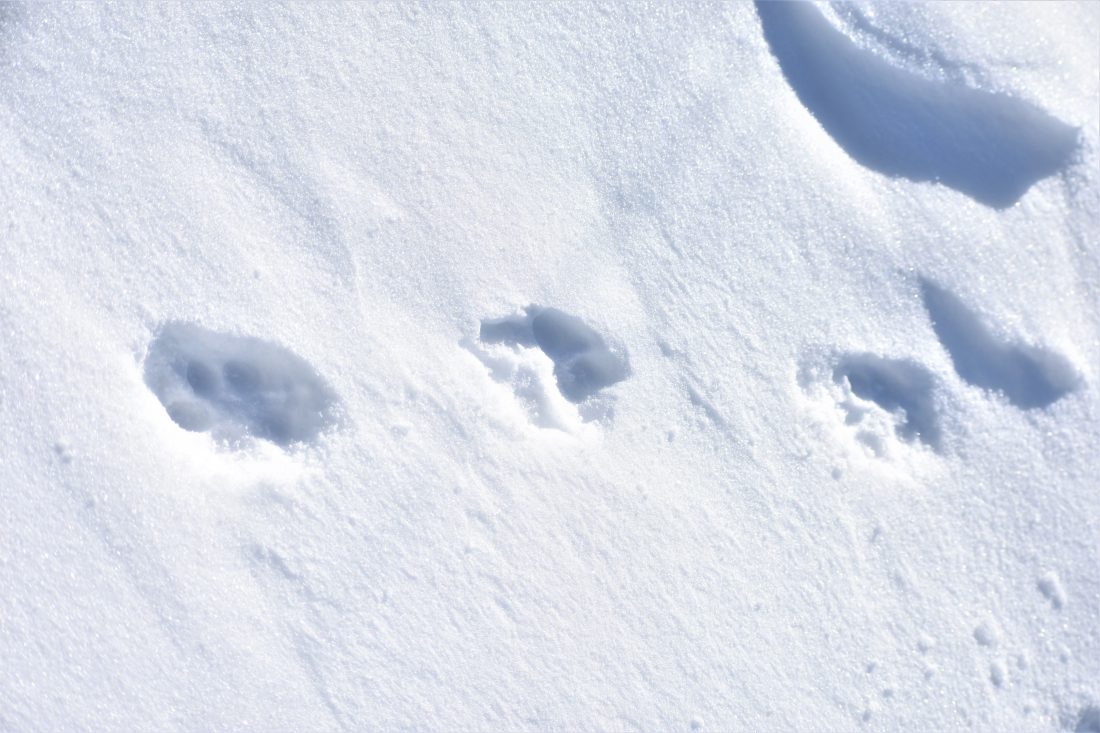From voles to bobcats — stories left in the snow
Northwoods Notebook
- Seeing tracks like these in the snow — round in shape rather than oval, paw pads with four toes and no visible claws — can be a sign that one of these is in the neighborhood.
- Betsy Bloom/Daily News photos

Seeing tracks like these in the snow — round in shape rather than oval, paw pads with four toes and no visible claws — can be a sign that one of these is in the neighborhood.
A fresh snowfall can reveal so much.
It’s a blank page, ready for creatures to leave a signature and write the latest part of their life stories.
When I worry that local animals that should be present seem scarce during winter, even a thin dusting of snow can be reassuring, bearing witness to what’s in the neighborhood that doesn’t trigger the trail cameras. The snow records paw prints, hoof gouges, ruffed grouse and wild turkey tracks shaped like tridents, fan patterns where birds launched or landed. Even the tiny parallel dots from a mouse or vole, with a line in between by the dragging tail, are like a natural Morse code communicating its continued survival — or sometimes its demise, when it ends with the imprint of a swooping raptor.
These tracks can indicate whether snowshoe hares remain in the area — I’ve regularly seen them in summer grazing on the lawn but never when they are glorious white for winter, which means their camouflage is working — and if their cottontail cousins have managed to elude their many predators.
It is among the many good reasons to strap on snowshoes or skis after nature puts down a new layer of the white stuff.

A few items can prove useful when venturing out to look at tracks, such as a field guide that illustrates foot shapes and track patterns. The internet also has guides that can be printed out for easy reference.
A cellphone can be used to call up websites — if able to get decent reception while out in the woods, of course. Some websites offer apps to make a quicker connection. The other advantage of having a cellphone is to photograph the more baffling tracks to identify later, when comfortably back at home. This may provide proof as well that an animal perhaps rare to these parts is in the region.
Another handy tool is a ruler or tape measure for dimensions and perspective when sorting out, say, whether a track with four clawed toes over a roughly triangular central pad might be wolf, coyote, dog or fox.
The Upper Peninsula is known to have a multitude of hardy winter mammals — nine possible members of the weasel family, at least one and perhaps three wild felines, four wild canines, two deer species (plus a wayward elk from Wisconsin, according to reports), both rabbit and hare, three to four types of squirrel and rodents large and small, ranging from beaver and porcupine to deer mice and voles.
Deciphering the patterns they leave in snow is a puzzle with a fun payoff. So enjoy the challenge of the stories left in the snow.

Betsy Bloom/Daily News photos
*****
Staying on the topic of wildlife in winter, the Marinette and Oconto offices of University of Wisconsin-Madison, Division of Extension will offer a free, four-part webinar series on the next four Thursdays through March 11.
The series will detail how winter weather changes might affect wildlife and plants, and how the region’s native wildlife adapt and adjust to winter to survive.
Each webinar will begin at 6:30 p.m. and last for 45 minutes to an hour, depending on questions. The discussion will be family-oriented and meant to engage learners of all ages.
Aimee Elkins and Scott Reuss, 4-H and agriculture/horticulture educators for the two counties, will lead the discussion. They will present a synopsis of each evening’s discussion, give examples of local wildlife and plants that utilize those survival methods and make sure all participants have access to resources that provide even more detail, if interested.
The four session’s topics are —
— Thursday: Hibernation
— Feb. 25: Dormancy
— March 4: Migration
— March 11: Torpor and adaptation
Pre-registration is required by noon the day of the program, so attendees can receive the event links and resource materials.
To register, go to tinyurl.com/LO932MMA or either the Oconto or Marinette County Extension offices’ webpages, or e-mail Elkins at aimee.elkins@wisc.edu to receive the registration link.
For more information on the events, e-mail the address listed above or call 715-732-7510.
*****
February marks when winter sunrise finally occurs before 7 a.m. and sunset after 5 p.m.
The first happened Friday at 6:58 a.m. While sunrise will flip back to being just after 7 a.m. when we adjust the clocks for daylight savings time March 14, it will be for only about a week and then the sun will not again sleep in past 7 a.m. this year until Oct. 8.
Sunset came after 5 p.m. on Feb. 3 and will extend beyond 5:30 by Feb. 24. The time shift March 14 will advance sunset to almost 7 p.m.
Yes, the darkness and shorter days of winter are receding.
Betsy Bloom can be reached at 906-774-2772, ext. 240, or bbloom@ironmountaindailynews.com.




